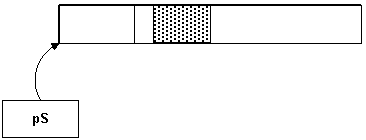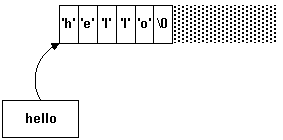C++ and Machine Architecture
The C++ language, following its foundation in C, is close to the machine architecture. This allows applications to be implemented efficiently, but, especially for developers new to the language, presents some issues of which you need to be aware. This topic reviews the basic language features from this perspective, and discusses how the resulting issues are handled.
Arithmetic types
An int is usually implemented as the natural machine word size of the particular implementation. This is 32 bits in most modern machines. It was 16 bits in older machines, and in a few machines it may even be 64 bits.
Similarly, a pointer (a void*, for instance) is usually implemented as a machine word but, in some machines with special architectures, a pointer may be more complex.
It is assumed that Symbian is implemented on a machine with a 32-bit or greater machine word, and 32-bit pointers. The types TInt and TUint are typedefed onto the built-in int and unsigned int types, and are guaranteed to be at least 32 bits.
When you need a specific size, regardless of implementation, use a sized type. Several of these are available:
TInt32, TUint32 |
32-bit signed and unsigned integer In each case, the representation is a 32-bit machine word which, in the ARM architecture, must be aligned to a four-byte boundary. The compiler ensures that this is always the case. |
TInt8, TUint8, TText8 |
8-bit signed and unsigned integer, and 8-bit character In each case, the representation is an 8-bit byte, which has no specific alignment requirements. |
TInt16, TUint16, TText16 |
16-bit signed and unsigned integer, and 16-bit character In each case, the representation is a 16-bit halfword, which should be aligned to a two-byte boundary. |
TInt64, TUint64 |
64-bit signed and unsigned integer These are typedefed to appropriate built-in types for the compiler being used (long long, and unsigned long long for ARM RVCT). |
TReal, TReal64 |
Double-precision floating point, IEEE754 64-bit representation This is the floating-point type recommended for general use. You are recommended to perform operations in integer arithmetic if possible (for instance, most GUI calculations), and to use floating-point only when the problem demands it (for instance, a spreadsheet application). On processors that have floating point hardware, the compiler generates host instructions which use that hardware directly. On processors which don't have a floating point unit, the compiler implements the calculations in software. |
TReal32 |
32-bit floating point This is smaller and quicker, but should only be used when space and/or time are at a true premium, as its precision is unsatisfactory for many applications. |
Compound types
Apart from classes, C++ inherits from C various other types of compounding.
A struct maps an area of memory:
struct TEg
{
TInt iInt; // offset 0, 4 bytes
TText8 iText; // offset 4, 1 byte
// 3 wasted bytes
TReal iReal; // offset 8, 8 bytes
} // total length = 16 bytes
Structures are regarded as T types: that is they may not own heap-allocated resources such as C type classes.
An array contains many built-ins or other types
TInt a[32]; // 32 TInts, = 128 bytes S b[3]; // 3 Ss, = 48 bytes
The main disadvantage of using C++ arrays is that there is no automatic checking of index values. For this reason, and to support more complex containers, C++ has evolved the Standard Template Library (STL). Symbian does not use STL, but provides its own range of efficient container classes, for fixed, dynamic, and associative arrays. For details, see Dynamic Arrays.
Pointers
A pointer is a memory address. If you can take the address of an object, then you can refer to it by pointer:
S* ps; // pointer to an S ps=&s // take address of existing S
A pointer is a 32-bit machine word, and could point to anything.
The specifier is placed next to the type rather than the name.
There is often a need to refer to memory as anything: for this, a void* pointer is used in C++. In Symbian, a TAny* may be referred to instead. A TAny* is a pointer to anything.
Strings
In C++, the basic string is an array of characters:
char* hello="hello";
This statement does two things: firstly, it sets aside six bytes of memory containing the characters 'h', 'e', 'l', 'l', 'o', '\0'. Secondly, it sets the pointer hello to contain the address of the first of those bytes.
Functions accessing the string rely on this address as its starting point, and the terminating \0 to indicate its end. Functions which manipulate the string must either deliberately not extend it, or must have some cue as to the amount of memory reserved for the string (beyond the trailing\0) so they know how much it can be extended. This leads to an awkward programming style, and every C++ library provides a way to manipulate strings more elegantly. The Symbian platform solution is descriptors: these are introduced in Descriptors
Functions
Functions are a piece of code which can be called and executed from anywhere else in a program. The stack is used to pass parameters and to contain local variables. The stack is often augmented by machine registers, especially in a register-rich processor such as the ARM, so that memory is often not used. But, conceptually, there is a stack, and for the purposes of this explanation it is convenient to consider the stack as if it were implemented entirely in memory.
Parameters are passed by copying or evaluating onto the called functions stack frame. It is bad practice to pass large parameters, such as an entire struct, or, in fact, anything beyond two machine words in size, because this involves excessive copying. Instead, a pointer or a reference should be used to pass the address, instead of the data itself.
In a multi-tasking system such as Symbian, each thread has its own stack, which is a pre-allocated area of memory. Each function then allocates its own frame from the stack on entry, and de-allocates it on exit. The advantage of the stack mechanism is that allocation and de-allocation are very rapid indeed— just a couple of instructions. Also, the lifetime of any variable on the stack is very well defined: it is the lifetime of its owning function, or, in fact, its owning block, since functions may have blocks within them.
When a function returns, its stack memory is still there: it is just not allocated. The stack memory will be re-used by the next function that is called. A potential source of error is to allocate an object on a functions stack frame, and then return a pointer to it:
TEg* foo()
{
TEg s;
TEg* ps=&s
return ps; // !! error !!
}
This pointer will not be valid for long, because the memory will be re-used when the next function is called. You should never allow this to happen. This error is so obvious that a compiler will trap it. But it can occur in more subtle forms:
foo(CContainer* aContainer)
{
TEg s;
TEg* ps=&s
aContainer->iMember=ps;
}
These cannot be trapped so easily.
Heap
Each thread also has a heap. You can allocate and de-allocate objects on the heap at will, and refer to them by pointer. The benefit of a heap is that the lifetime of an object is entirely within your control. This power comes with responsibility: you must not forget to de-allocate objects once you have finished with them, and you must not use pointers to objects that have been de-allocated.


